The Victorian Christmas tree was decorated with edible Christmas tree decorations such as fruits, nuts, homemade Christmas candy and cookies but also with DIY Christmas ornaments.
In the Victorian era, Christmas trees were usually decorated with real fruits and nuts. Fruits, like apples and oranges, as well as nuts, such as walnuts and acorns, were either used in their natural state or gilded with gold paint or imitation gold leaf before hanging on the Victorian Christmas tree.
The Victorian Christmas tree was decorated with ‘gilded and shining fruits’: ‘apples, nuts, and all sorts of sweetmeats between burning wax-tapers.’ (The Guardian, 1865)
Related: The Victorian Christmas Tree
Apart from these natural Christmas ornaments, DIY Christmas ornaments that could be easily made at home were also popular Christmas tree decorations in the Victorian era.
Apples
Christmas trees in the Victorian era were often decorated with fruits: Apples were especially popular.
‘The tree was hung with rosy-cheeked apples, oranges, bananas, bunches of grapes and strings of popcorn. There were bright tinsel ornaments too, and a goodly array of gaily dressed paper dolls’ (Christmas with Grandma Elsie, 1886).
You could either decorate your Victorian-style Christmas tree with real apples: Choose the prettiest and reddest apples for your Victorian Christmas tree decorations. Use larger apples for a large Christmas tree, and smaller apples for a small Christmas tree.
But if you don’t want to use real apples, you could also artificial apple Christmas tree ornaments: Imitation apple ornaments were already popular in the Victorian era.
‘Imitation oranges and apples have a lighter effect upon the tree than real ones’ (Bazaar Exchange and Mart, and Journal of the Household, 1875). ‘The Christmas-tree with its artificial flowers and fruits, its candles and paper blossoms, its golden apples and nuts’ (Folklore, 1892).
Real apples were sometimes gilded with imitation gold leaf (thin brass sheets). Here‘s a photo of antique imitation gold leaf for gilding nuts and apples as Christmas tree decorations.
The Christmas tree was decorated with ‘real fruit, made artificially dazzling with gold leaf’ (Households Words, 1850s). ‘Fruit or nuts may be painted with gold paint, or covered with gilt paper, and hung to the tree with colored ribbon.’ (The Young Folk’s Cyclopaedia of Games and Sports, 1890)
By the way, apples were one of the most ancient Christmas tree decorations: German Christmas trees were already decorated with red apples as early as 1604!
Oranges
Oranges were another popular Victorian Christmas tree ornament.
‘Then the ladies called us into another room and there was the Christmas tree! O mother! you never saw any thing so lovely! There were dozens of little candles upon it all alight. And it was covered with pretty things, gilded walnuts, and oranges, and apples, and sweets.’ (Philips’ Series Of Reading Books For Public Elementary Schools, 1874)
Like apples, oranges could be real or faux. And instead of whole oranges, you could also use dried orange slices. Dried orange slices are still popular today because these natural Christmas ornaments are easy to make at home.
Related: How To Make Dried Orange Slices
‘Strings of pop-corn, gilded nuts and apples, and bright yellow oranges are suspended from the tree, and also quantities of the sparkling lamietta’ (Demorest’s Family Magazine, 1891).
Berries
Red berries,such as holly berries or rose hips, were cheap and readily available. So, like today, they were used to decorate the Christmas tree in the Victorian era.
Related: How To Make Rosehip Wreath Ornaments
‘Strings of imitation holly berries, and bunches of real berries with all their leaves removed make bright decorations.’ (Bazaar Exchange and Mart, and Journal of the Household, 1875)
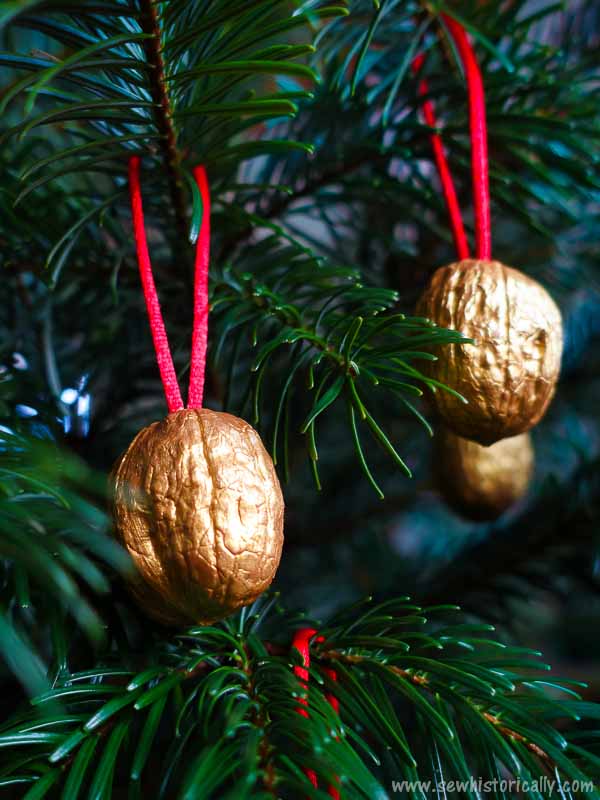
Gilded Walnuts & Acorns & Leaves
Apart from fruits, nuts were also popular Victorian Christmas tree decorations.
The ‘Christmas tree, lighted up with tapers, and hung round with gilded walnuts and flowers.’ (Letters from Hofwyl, 1842)
Related: How To Make Victorian Gilded Walnuts
Nuts, such as walnuts and acorns, were usually gilded with imitation gold leaf – like metal tinsel in sheet form – or gold paint before being used to decorate the Victorian Christmas tree.
‘For Christmas-trees much is done with gold paint. Before the liquid gold was provided, the article, say a walnut, was washed over with white of egg, then rolled in leaf-gold and allowed to dry.
This cost more than the ornament was worth, but one bottle of Judson’s gold paint will go a long way in gilding walnuts, acorns, little baskets for sweetmeats, and the many miscellaneous trifles which brighten up the sombre fir branches. A light tack must be driven into the walnut for a handle during the gilding process, and it serves to tie the suspending string to afterwards.’ (Household Words, 1883)
Related: How To Make Victorian Gilded Acorns
Traditionally, golden nuts were preferred as Victorian tree decorations but silver nuts were also used.
Large walnuts are’ coated over with gold and silver tinseled paper alike for bedecking the tree.'(Beloit College Monthly, 1868)
But not only nuts, leaves were also gilded as Victorian Christmas tree ornaments.
‘Oak-leaves and acorns may be bronzed or gilded with charming effect; as also the smaller pine cones’ (Cottage Hearth, 1886).
Related: How To Make Gilded Leaves
Popcorn Garlands
To simulate snow, Victorian Christmas trees were often decorated with popcorn garlands. While most Christmas tree decorations have a German origin, popcorn garlands are an American tradition.
‘It was the Christmas of ’67, and the country was still suffering the immediate effects of a long warfare. […] But there were countless little children for whom war had no meaning, and these little ones had to have Christmas joy […] A bit of stunted evergreen, trimmed with popcorn strung on a thread, a few red cranberries similarly fixed, [and] a few bits of tallow candles’ (The Commoner, 1904).
Popcorn garlands could be cheap and easy made at home. They still are a popular Christmas craft for kids.
‘Pop corn strung on thread and intertwined among the branches looks well.’ (The Young Folk’s Cyclopaedia of Games And Sports, 1890)
To make faux snow garlands, popcorn was threaded on a string using a needle. And to create a nice contrast, popcorn was often combined with cranberries.
‘Such a tree, hung with bright apples and oranges, popcorn and cranberries and other simple decorations will delight the children immensely.’ (The Gem State Rural, 1910)
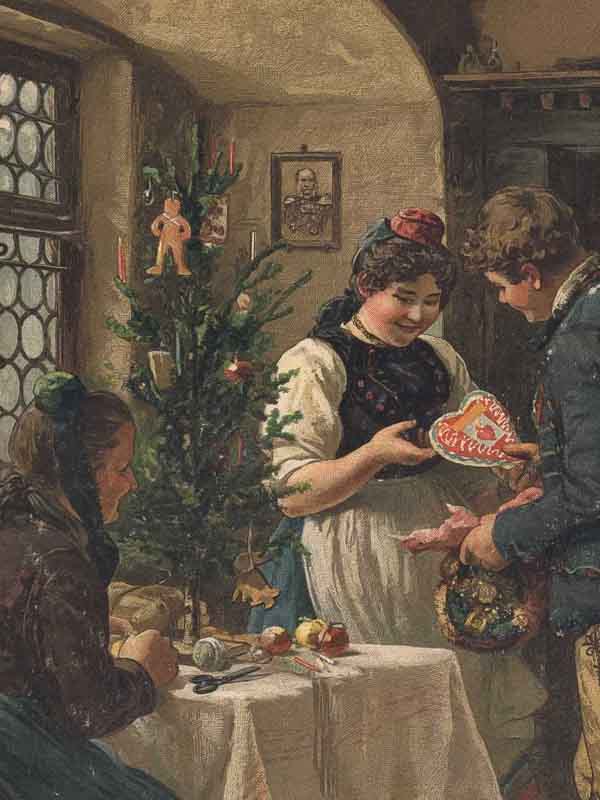
Cookies & Candy
Victorian Christmas tree ornaments were often edible. Apart from fruits, nuts and popcorn strings, cookies and candy were used to decorate the Victorian tree.
Related: Medieval Gingerbread Recipe
The Christmas tree was ‘loaded with brilliant candles, bonbons, and toys’ (Demorest’s Family Magazine, 1891). ‘Many a tree owes a good part of its charm and beauty to the cookies hung upon it.’ (Make It And Make It Pay, 1949)
‘Bon-bons, toys, dolls, baskets of sweets, are all appropriate, so long as each article shows up brightly or glitters against the dark background of the boughs.’ (The Book Of The Home, 1900) ‘Christmas-tree ornaments in gelatine, [and] decorative sugars’ (The British Trade Journal and Export World, 1884).
Edible sugar Christmas tree ornaments were one of the oldest decorations. Medieval German cookbooks show a variety for homemade sugar ornaments, flavored with lemon, quinces, almonds, rosewater, aniseed, and other fruits, flowers, herbs and spices.
Related: How To Make Victorian Sugar Ornaments
‘It was the Christmas of ’67 […] the good mother secured a bit of old-fashioned New Orleans sugar, and out of it she manufactured some candy and moulded it into fantastic shapes. […] There must have been a couple of pounds of it upon this particular Christmas tree. […] A few apples, some hickory nuts, some doughnuts’ (The Commoner, 1904).
Here‘s a German recipes from the 17th century for ‘Citron Lebzelten’ (lemon candy) which I tried: they were delicious! To make the 1600s lemon candy, you need the juice, yellow peel and white pith of the lemon. Soak 1/2 pound of the white pith in water for some hours, then cook it, press out the water and pound it with 3/4 pound sugar in a mortar. Add the juice of 2 lemons and cook it until translucent. Let it stand at room temperature overnight, then add finely cut yellow peel of all the lemons. Then press the sugar dough into springerle molds.
Traditionally, marzipan and sugar ornaments were always shaped with springerle or marzipan molds. After drying, these edible Christmas ornaments were often painted with natural food coloring made with fruits and vegetables, such as beetroot, saffron, elderberries, spinach etc.
‘The oldest record we have of a Christmas-tree dates from 1604, in Strasburg, in Alsace. […] At Christmas, a fir-tree is put into the room, on which are hung roses made of colored paper, apples, wafers, tinsel, sweetmeats, etc.’ In the 1640s, the Christmas tree ‘is hung with dolls and sweetmeats, and afterwards shaken and plundered.’ (Folklore, 1892)
Victorian Christmas candy and cookies were hung on the tree with green thread or colorful ribbon.
‘Glass birds and butterflies and all kinds of sugar ornaments look light and pretty. Clusters of sugar cherries or plums are very effective […] Sugar rings, sugar pipes, and other sugar trifles can be suspended from the tree without difficulty by means of strong green thread’ (Bazaar Exchange and Mart, and Journal of the Household, 1875).
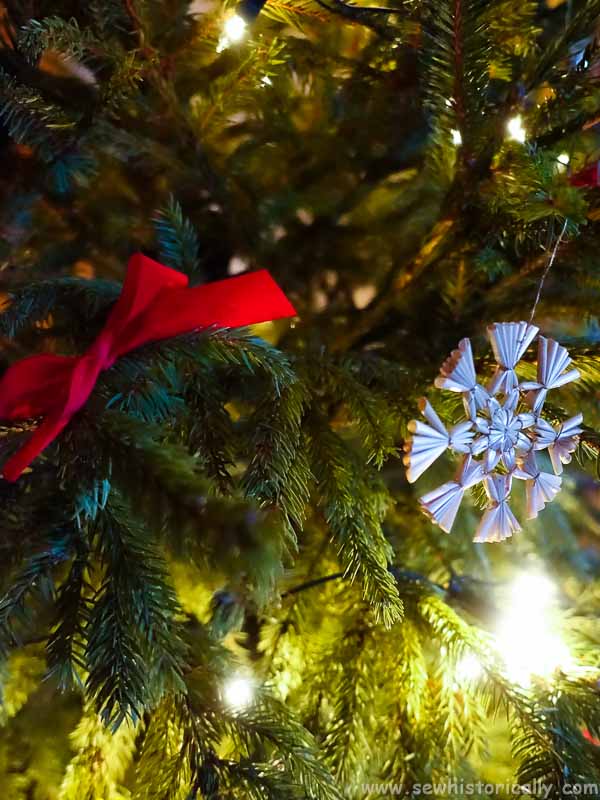
Straw Ornaments
In the Victorian era, straw was a popular material for hats, bonnets and as dress trimmings. And because straw was cheap and readily available, it was also used to make Christmas tree decorations. ‘There are straw ornaments for Christmas decorations’ (American Motherhood, 1911). And in Silesia, the Christmas tree was decorated with straw chains in the late Victorian era (Floegels Geschichte Des Grotesk Komischen, 1888).
There were also many superstitions associated with Christmas straw or Yule straw:
In Sweden on ‘Yule night the floor is often covered with straw and strewn with twigs of spruce, pine, or juniper. Christmas night the family all sleep in one room, the children on the straw-covered floor, “to commemorate the fact that the child Jesus made his advent into the world on a bed of straw.” […] A gay straw cock hangs from the ceiling over the table’ at Christmas day (The Phrenological Journal and Life Illustrated , 1883).
Related: How To Make Old-Fashioned Straw Christmas Ornaments
‘In commemoration of the fact that the Creator of all things had, as an infant, lain upon straw, it was a practice at Christmas to strew the houses and churches with straw; and from this custom arose many superstitions […] In Sweden, the houses as well as churches are littered with straw; and it is still believed, that if given to cattle when they are first sent out to pasture, it protects them from sickness […]
In the Sclavonian districts […] they cover the floors of their huts with straw, and put bundles of straw in the corners of their rooms. […] In Thuringia, it has also been the custom to tie bundles of wet straw upon Christmas night round the stems of the fruit-trees, for the purpose of having a good crop.’ (The Home And Foreign Review, 1863)
Wax Ornaments
Beeswax Christmas tree ornaments are another traditional Christmas tree decoration. Instead of beeswax, the Victorians sometimes used sealing wax to make wax Christmas ornaments because sealing wax came in different colors.
Christmas ornaments ‘made of wire and different colours of sealing-wax.’ (The Guernsey Magazine, 1872)
Ribbons
Every Victorian household had bits of ribbon at home, so ribbons were another easy and cheap tree ornament.
‘The large tree stood on a low table, and reached nearly up to the ceiling. There were only lights, colored ribbons, and gilded walnuts hung upon it’ (Catholic World, 1876). ‘Ribbon bows, strings of bright beads, loose braided chains of gilt or silver paper, will light up the boughs.’ (The Book Of The Home, 1900)
Paper Cornucopias
Instead of hanging candy from the branches, cornucopias were made with gold, silver or colored paper, filled with candy and hung on the tree.
‘Coloured paper cornucopias, ornamented with gold tassels, can be filled with sweets’ (Bazaar Exchange and Mart, and Journal of the Household, 1875). ‘Old-fashioned cornucopias made of colored paper, and made at home, look hundred times better and fitter in the green’ (The L’Anse Sentinel, 1909).
‘Cornucopias, rounded from silver paper, are effective ornaments and are a good substitute for candy boxes.’ (The Savannah Morning News, 1904) ‘Gold, silver and all manner fancy colored paper […] must be made into “cornucopiae,” and these filled with an assortment of candy, nuts, cakes, &c.’ (Beloit College Monthly, 1868)
‘The little pail, baskets, and bag, to hold bonbons, are easily made of gilt or silver covered pasteboard, with pink, blue, and red satin ribbons to tie them up. The pail and bag have satin bags sewed inside. […] Pretty cornucopias may be made […] by cutting triangles of cardboard in any desired size, and covering them with colored paper. Sew the shortest edges together, round off the top, cover with gold, silver, red, or blue paper. Finish the top with paper lace and a band of gilt paper, and fasten a wire hook to it to hang it up by.’ (Demorest’s Family Magazine, 1891)
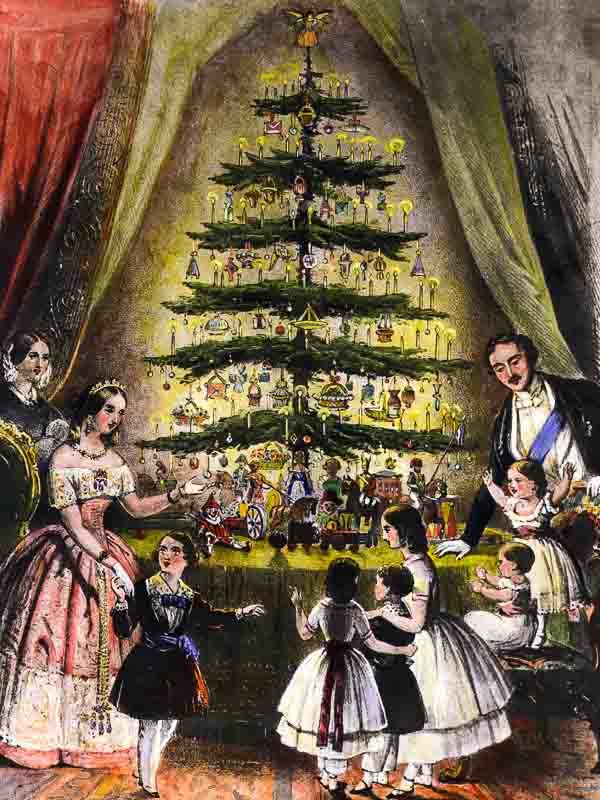
Paper & Cardboard Ornaments
Paper ornaments were popular Victorian Christmas tree decorations because they were inexpensive and kids could help in making them. Embossed cardboard ornaments covered with gilt or silver paper are today know as Dresden ornaments.
Related: How To Make Victorian Embossed Paper Ornaments
‘Loose braided chains of gilt or silver paper, will light up the boughs.’ (The Book Of The Home, 1900) ‘Almost anything bright colored or shining looks well on a Christmas tree. Pasteboard cut into odd shapes and covered with gilt or colored paper, bits of new tin or looking glass’ (The Young Folk’s Cyclopaedia of Games and Sports, 1890). ‘Christmas-tree ornaments, made of gilt paper, representing animals, pipes, fishes, etc.’ (Treasury Decisions Under Customs and Other Laws, 1908)
‘That night they trimmed the Christmas tree with such pathetic odds and ends of colored paper rosettes, gilded walnuts, popcorn strings, and wax-choked, tin candle-holders (Good Housekeepin, 1919) ‘At Christmas, a fir-tree is put into the room, on which are hung roses made of colored paper’ (Folklore, 1892).
‘Gold, silver and all manner fancy colored paper […] must be cut into long feathery strips, and is to encircle the tree’ (Beloit College Monthly, 1868). ‘A circle of bright flags should be wired to the stem of the tree […] they are made of thick paper, with a wire run through them for a pole, and are coloured to represent the flags of all nations.’ (Bazaar Exchange and Mart, and Journal of the Household, 1875).
‘Anything that the children can do personally toward decorating the Christmas tree adds just as much to their pleasure, and the variety of pretty and appropriate decorations which are within the scope of their small fingers is almost illimitable. In every kindergarten in the city little folks are busy now making artistic paper chains, vari-colored Japanese lanterns, paper balls and baskets, and scores of other pretty trinkets that can be concocted at trifling expense. […]
Some dainty and inexpensive gifts to be hung on a tree may be made out of gray or green bristol board, cut into oblong shapes and decorated with a miniature calendar and a small photograph of an appropriate subject. A ribbon of red or white run through two holes at the top makes it easy to hang this little present to a tree.’ (Evening Star, 1906)
Related: 10 Victorian Christmas Gift Wrapping Ideas
‘If there are apparently useless bits of gold or silver paper left, roll them over a knitting-needle into little slender horns, and hang them also to the tree, and they will add no inconsiderable item to its festal array.’ (Demorest’s Family Magazine, 1891)
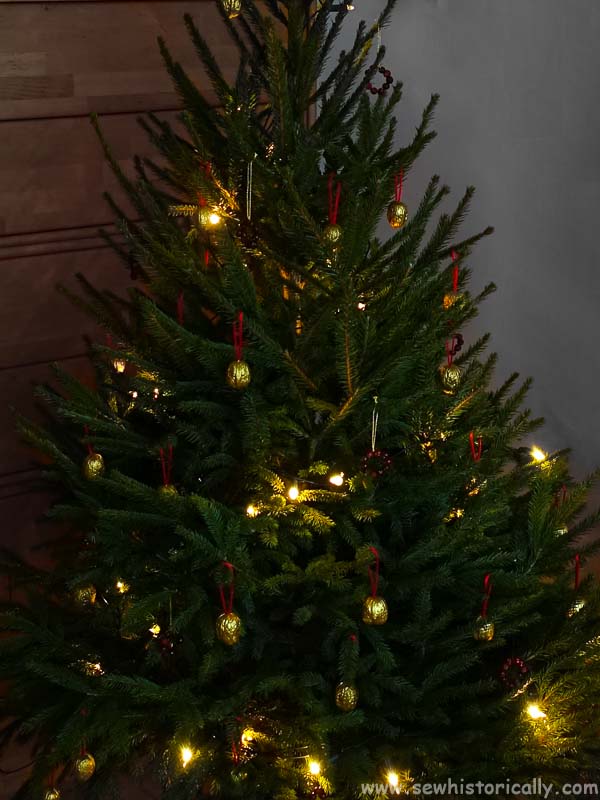
Christmas Gifts
The main function of the Christmas tree was to display Christmas gifts. Small gifts like tin toys, pin cushions, pen wipers, dolls were hung upon the branches of the Victorian Christmas tree with ribbons.
Related: Homemade Victorian Christmas Gifts
Christmas gifts were ‘hanging from the branches which bend under the load of good things.’ (San Francisco Call, 1905) ‘There were rosy-cheeked dolls, hiding behind the green leaves; and there were real watches […] dangling from innumerable twigs; there were French-polished tables, chairs, bedsteads, ward- robes, […] wonderfully made, in tin […] there were fiddles and drums; there were tambourines, books, work-boxes, […] there were baskets and pincushions in all devices ; there were guns, swords, and banners […] There was everything, and more’ (Households Words, 1850s).
‘Of course there was a jumping-jack on that Christmas tree. It was a home-made toy […] clothed in a suit of […] elderberry juice […] and a ball made by ravelling out a yarn stocking’ (The Commoner, 1904).
Related: DIY Victorian Rag Ball
Tinsel
Whereas tinsel was usually store-bought in the Victorian era, homemade Christmas tree ornaments were often made with tinsel.
‘The Christmas tree was decked with tinsel ornaments and tiny tapers.’ (The Sunday At Home, 1882) ‘In order to brighten the tree as much as possible […] little tinsel star made of gold and silver coloured paper will come in usefully.’ (Bazaar Exchange and Mart, and Journal of the Household, 1875).
Tinsel was made of thin metal sheets – copper, brass or tin – that was cut into thin strips. Tinsel – also known as lametta – was either gold or silver.
‘Quantities of the sparkling lamietta, the narrow strips of tinsel that are sold in packages for the purpose.’ (Demorest’s Family Magazine, 1891)
‘Christmas-tree ornaments in lengths suitable for tying into garlands or festoons. Each piece is made of round metal wires wound with cotton thread and thickly set with short pieces of tinsel of various colors with points projecting outward. […] tinsel wire, lame, or lahn, […] known as “angel’s hair,” “shavings for Christmas trees,” “lametta,” etc., […] consisted simply of bunches of tinsel.’ (Treasury Decisions Under the Customs, Internal Revenue, Industrial Alcohol, Narcotic and Other Laws, 1899)
Wire Ornaments
Before tinsel became popular as Christmas tree decoration, leonic wire ornaments were used to decorate Christmas trees since the Medieval Period! Leonic wire is silver-plated or gold-plated thin drawn wire, either flat, crimped or coiled like bullion wire. Apart from Christmas ornaments, leonic wire was also used to make metal lace and similar wire is still used today for gold work embroidery. Leonic wire Christmas tree ornaments were still popular in the Victorian era and even as late as the 1920s and 1930s. Here’s an antique Christmas ornament with leonic wire.
Inspired by antique leonic wire Christmas tree ornaments, I made small wire star ornaments.
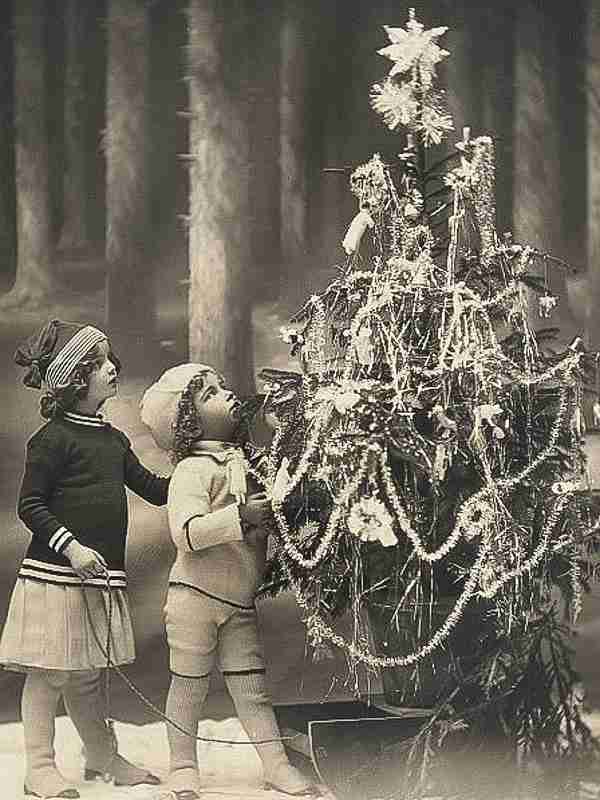
Tin Ornaments
‘The splendid advent-star, which can be hung either over the Christmas tree, or at the ceiling over the lamp, where the constantly rising heat will keep it in perpetual motion, sparkling and glittering, is quite easy to make.
Related: How To Make Tin Star Ornaments From Tin Cans
For the foundation, have a thin piece of tin cut with eight radiating pieces, twelve inches in diameter, and of the shape illustrated […] Each ray is about an inch wide, and should have about three cuts, an eighth of an inch long, down the middle, to fasten on the outer part.
The separate star-pieces are cut of cardboard, and are nearly five inches longer than the tin rays, and measure from one to three and a half inches in width. Cut eight of this size and of the shape shown, and cover each with gilt paper. Fasten them with wire to the center of the foundation, cut a small eight-pointed star of cardboard about three inches in diameter, and fasten this on with a gilt-headed pin run through all and bent over at the back. Then coat all the star with thin gum, and sprinkle it, before it is quite dry, with diamond powder. To the points of the star hang little cardboard dolls dressed like angels.’ (Demorest’s Family Magazine, 1891)
Tinfoil & Tinsel Ornaments
‘To decorate the Christmas tree there are ‘many pretty novelties which can be made at home by the children, or at least which the children can help to make. The flower and butterfly illustrated are brilliantly beautiful, and are made of wire, – spiral wire, if possible, – tinfoil, lamietta, and “flitters,” in different colors.
The wire is first looped to give the shape of the flower leaf (see illustrations), and then a foundation prepared by crossing it with wire. Over this tinfoil is covered on both sides, and when a sufficient number of petals are thus made, they can be mounted as shown in the completed flower, shaping the leaves by bending the wire.
For the center of the flower, tie a bunch of lamietta to a wire, and add three or four single pieces of wire with a gilt bead fastened at one end, for stamens. Cover with tinfoil all the wire used to mount the flower, and make a loop to hang it up with. Any flower may be made in the same way, the one illustrated having the semblance of a fuchsia, with seven leaves in all'(Demorest’s Family Magazine, 1891).
Related: How To Make An Edwardian Tinsel Fuchsia With Ribbon
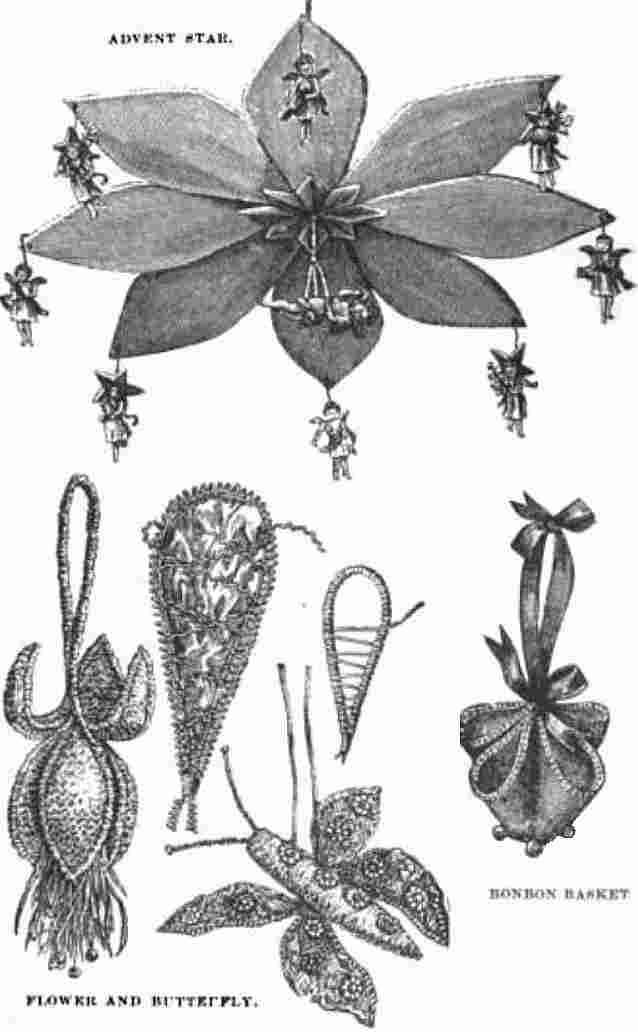
Cotton Snowballs & Icicles
Christmas trees were already frosted in the Victorian era. The Victorian Christmas tree was frosted with cotton, glass glitter and mica powder.
Related: How To Make A Cotton Snowball Garland
‘Tie cotton on the branches to resemble snow.’ (The Gem State Rural, 1910) ‘Sheet wadding snowballs may be formed and fastened to the tree by a thin wire.’ (The Savannah Morning News, 1904) ‘Cotton-wool dipped in thin gum and then in diamond-dust [mica powder] makes beautiful frosting’ for the tree (Demorest’s Family Magazine, 1891).
‘Before commencing any decorations, the tree should be “frosted.” […] The branches to be covered must be either wrapped round thickly with jeweller’s cotton wool, or it must be glued on to them in large quantities very firmly. Then a large-toothed comb or fork must be taken, and the wool combed out, so as to hang down in long fleecy waves of various lengths; and afterwards strong white gum must be sprinkled over the wool, and powdered glass shavings dusted thickly over, so as to adhere to the gum, and give the appearance of sparkling snow to the wool.’ (Bazaar Exchange and Mart, and Journal of the Household, 1875)
Glass Prism Icicles
Apart from store-bought glass Christmas balls, glass prisms were used as Victorian Christmas tree decoration. In the Victorian home, glass prisms decorated lamps and chandeliers. But on the tree, these crystal prisms look like icicles.
The Christmas tree ‘splendent with wax candles, icicles of glass, and balls of glittering metal.’ (Conneticut Western News, 1873) ‘Oblong drops of glass like those need in lustres and chandeliers will also help to make the tree bright by reflecting the light from the candles.’ (Bazaar Exchange and Mart, and Journal of the Household, 1875)
To make DIY glass icicles, you can buy crystal chandelier beads and simply connect them with wire. Crystal prism icicles are one of my favorite Victorian Christmas tree ornaments! 😀
‘Long crystal prisms which dangle from old-fashioned lamp globes or candlesticks, if removed and hung, one on the tip of each branch, give the effect of icicles in the sunlight, on a morning after Jack Frost has visited the trees in the midst of a rain storm.’ (The Savannah Morning News, 1904)
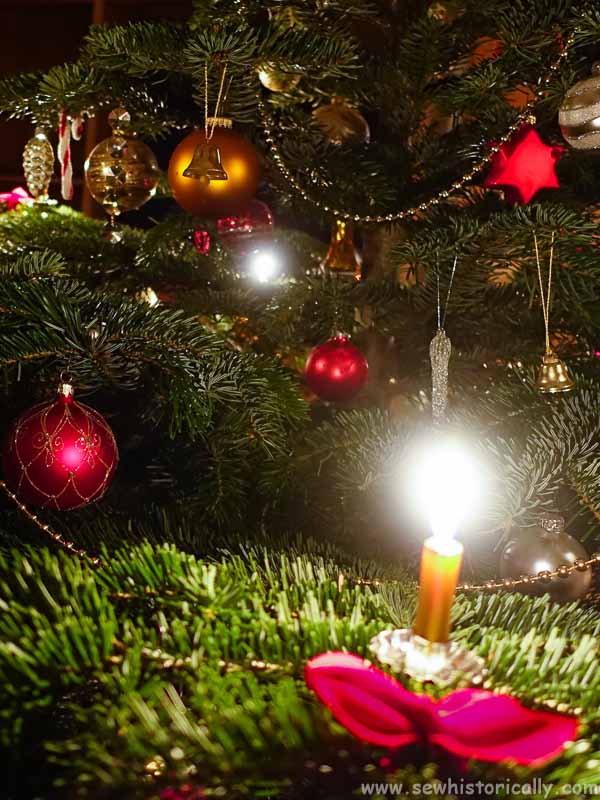
Candles
Victorian Christmas trees were illuminated with candles. Candles – usually called tapers back then – were made of beeswax, paraffin, stearic acid and tallow in the Victorian era.
‘In Germany, the birthplace of the Christmas-tree, flowers and tapers are its chief adornment.’ (The Book Of The Home, 1900) ‘Wax candles are the only real thing for a Christmas tree, candles of wax that mingle their perfume with that of the burning fir’ (The L’Anse Sentinel, 1909).
While rich families bought their Christmas candles, poorer families usually made their own candles at home with tallow.
The tree was ‘trimmed with […] a few bits of tallow candles’ (The Commoner, 1904).
Tallow candles were either dipped or molded. If you want to make your own tallow candles – as Christmas candle or emergency candle for a power outage – they are really easy to make: All you need is suet and cotton string or rushes.
Related: How To Make Victorian Tallow Candles
White was a popular candle color but red was also popular for Christmas tree candles.
‘Here was a magnificent Christmas-tree hung all over with colored wax tapers’ (An American Family In Germany, 1866). The Christmas tree was ‘brilliantly illuminated with red wax tapers.’ (The Times Dispatch, 1904) ‘Colored tapers, burning brightly, transform the whole into a pyramid of light.’ (The Current, 1884)
Tallow and wax candles were fixed to the Victorian Christmas tree with tin candle holders, pins, wire or melted wax.
‘To fix the tiny tapers on the tree is always a difficult task. The best way is to push large strong pins through the twigs, with the point upwards, and impale the candles on these.’ (The Book Of The Home, 1900) ‘Trees are usually lighted with colored tapers, about three inches long, fastened to the branches with holders. The best holders are fitted to a wire, which has at the lower end a colored ball the weight which keeps the candle upright. Others are fastened to the branch with sharp ends’ (The Young Folk’s Cyclopaedia of Games and Sports, 1890).
‘Tin sockets […] bound on to the tree with wire, in such positions that the lighted candles placed in the sockets do not come under any boughs, or near to any presents. […] Upon some of the upper boughs larger coloured candles can be attached by cutting a tiny piece out of the bough, and pressing the candle into this cavity, and keeping it in its place by wiring it.’ (Bazaar Exchange and Mart, and Journal of the Household, 1875)

Paper Lanterns
Because candles were difficult to attach to the Christmas tree, paper lanterns were often used instead of candles. These small lanterns were made of paper, either round or rectangle.
‘In every case the Christmas tree is illuminated. If it is a big tree it is hung with hundreds of Chinese lanterns and candles, which throw a brilliant light over the imposing array of presents hanging from the branches’ (San Francisco Call, 1905).
‘Nothing is more effective for a tree ornament than a Japanese lantern made out of two colors, preferably gilt and red, or gilt and blue. Such a decoration is made by folding a square piece of paper into a book, by laying the front and back edges together and then folding these again into shutters by laying the edges together.
Make as many shutters as can be conveniently folded, then unfold and fold again into a book on the opposite side. Roll over the edges to the first crease and cut down each crease to the folded edges. On the other strip put paste and glue the other edge to it, making the lantern. At the top paste on the inside a handle, made of a narrow strip of paper, in a shade to match either of the colors of the lantern.’ (Evening Star, 1906)
Victorian paper lanterns, however, were dangerous since the paper could easily catch fire.
‘Small Chinese lanterns, both round and long, look very well, but they are dangerous to use, as their paper catches fire, and falls down upon the other articles. Long sticks with wet sponges tied to one end should be kept in readiness, to put out with promptness any indications of a conflagration.’ (Bazaar Exchange and Mart, and Journal of the Household, 1875).
Please Pin It!

